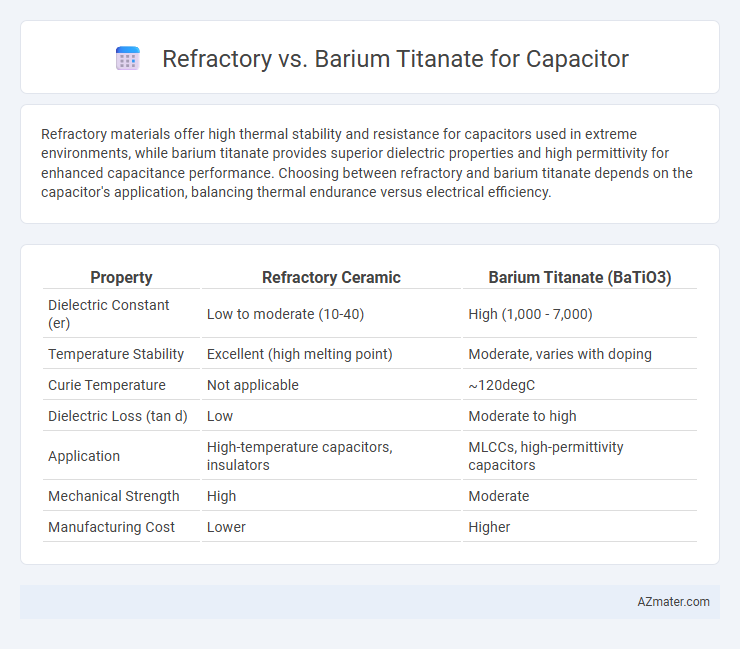Refractory materials offer high thermal stability and resistance for capacitors used in extreme environments, while barium titanate provides superior dielectric properties and high permittivity for enhanced capacitance performance. Choosing between refractory and barium titanate depends on the capacitor's application, balancing thermal endurance versus electrical efficiency.
Table of Comparison
| Property | Refractory Ceramic | Barium Titanate (BaTiO3) |
|---|---|---|
| Dielectric Constant (er) | Low to moderate (10-40) | High (1,000 - 7,000) |
| Temperature Stability | Excellent (high melting point) | Moderate, varies with doping |
| Curie Temperature | Not applicable | ~120degC |
| Dielectric Loss (tan d) | Low | Moderate to high |
| Application | High-temperature capacitors, insulators | MLCCs, high-permittivity capacitors |
| Mechanical Strength | High | Moderate |
| Manufacturing Cost | Lower | Higher |
Introduction to Capacitor Dielectric Materials
Capacitor dielectric materials impact key properties such as dielectric constant, breakdown voltage, and temperature stability. Refractory materials offer high thermal resistance and mechanical strength but typically exhibit lower dielectric constants compared to barium titanate, a ferroelectric ceramic known for its exceptionally high permittivity and tunable electrical properties. Barium titanate's high dielectric constant enhances energy storage in capacitors, making it preferable for applications requiring miniaturization and high capacitance, while refractory dielectrics serve better in high-temperature or harsh environment conditions.
Overview of Refractory Materials
Refractory materials, known for their high thermal stability and resistance to chemical degradation, are essential in capacitor applications requiring robust performance under extreme conditions. These materials, including alumina and zirconia, offer superior mechanical strength and insulation properties compared to barium titanate, which primarily excels in dielectric permittivity but has lower thermal durability. Selecting refractory materials enables capacitors to maintain structural integrity and consistent electrical behavior in high-temperature and high-stress environments.
Barium Titanate: Key Properties and Applications
Barium titanate, a ferroelectric ceramic material, exhibits high dielectric constant, excellent piezoelectric properties, and strong temperature stability, making it ideal for capacitor applications requiring high permittivity and low loss. Its ability to maintain capacitance under varying temperature conditions and strong electrical insulation makes barium titanate capacitors highly efficient in multilayer ceramic capacitors (MLCCs) and embedded electronic circuits. Compared to refractory materials, barium titanate offers superior semiconductor behavior and flexibility in tuning electrical properties for advanced energy storage and sensing devices.
Dielectric Constant Comparison: Refractory vs Barium Titanate
Barium titanate exhibits a significantly higher dielectric constant, typically ranging from 1000 to 5000, making it ideal for high-capacitance capacitor applications. Refractory materials, on the other hand, generally have much lower dielectric constants, often below 500, limiting their use in miniaturized capacitors requiring high energy density. The superior dielectric constant of barium titanate directly enhances capacitor performance by allowing greater charge storage in smaller volumes.
Temperature Stability and Performance
Barium titanate capacitors exhibit excellent temperature stability due to their high dielectric constant and stable permittivity across a wide temperature range, making them ideal for applications requiring consistent performance in varying thermal environments. In contrast, refractory metal capacitors offer superior performance under extreme temperature conditions, maintaining functionality and reliability in high-temperature applications above 200degC, where barium titanate materials may degrade. Selecting between refractory and barium titanate capacitors depends on the operating temperature range and performance requirements, with refractory capacitors favored for harsh environments and barium titanate preferred for stable, high-capacitance needs at moderate temperatures.
Voltage Endurance and Reliability
Refractory materials in capacitors offer superior voltage endurance due to their high melting points and thermal stability, maintaining performance under extreme electrical stress. Barium titanate, prized for its high dielectric constant, provides excellent capacitance but often exhibits lower voltage endurance and reliability, especially under high voltage or temperature fluctuations. Engineering choices prioritize refractory elements for applications demanding robust voltage tolerance and long-term reliability, while barium titanate suits designs focused on maximizing capacitance within moderate voltage ranges.
Manufacturing Processes and Cost Analysis
Refractory metals like tungsten and molybdenum used in capacitors require high-temperature sintering processes, resulting in increased manufacturing complexity and cost compared to Barium titanate, which utilizes lower-temperature ceramic processing techniques such as tape casting and sintering. Barium titanate benefits from mature, scalable production methods that reduce material waste and energy consumption, leading to more cost-effective mass production. The higher raw material and energy costs associated with refractory metal capacitors generally make Barium titanate capacitors more economically favorable for high-volume applications.
Applications in Modern Electronics
Refractory materials are favored in high-temperature capacitor applications due to their excellent thermal stability and resistance to degradation, making them ideal for power electronics and aerospace components. Barium titanate, a ferroelectric ceramic with high dielectric constant and tunable permittivity, is widely utilized in multilayer ceramic capacitors (MLCCs) for consumer electronics, automotive sensors, and wireless communication devices. The choice between refractory and barium titanate capacitors depends on the operational environment and performance requirements such as temperature tolerance, dielectric loss, and frequency response.
Environmental Impact and Sustainability
Refractory materials often contain heavy metals and require high-energy processing, leading to increased carbon emissions and landfill waste, whereas barium titanate is a more environmentally friendly ceramic with lower toxicity and better recyclability. Barium titanate capacitors contribute to sustainability through their longer lifespan and reduced need for hazardous chemical disposal compared to refractory-based alternatives. Life cycle assessments highlight barium titanate's advantages in minimizing ecological footprint and supporting green electronics manufacturing.
Future Trends in Capacitor Material Innovation
Refractory materials offer high thermal stability and durability for capacitors used in extreme environments, while barium titanate provides superior dielectric properties and high permittivity, enabling miniaturization and enhanced energy storage. Future trends in capacitor material innovation emphasize combining refractory robustness with barium titanate's dielectric efficiency to develop hybrid composites that improve both lifespan and capacitance. Advances in nanostructuring and doping techniques aim to optimize these materials for next-generation applications in electric vehicles, renewable energy systems, and high-frequency electronics.

Infographic: Refractory vs Barium titanate for Capacitor
 azmater.com
azmater.com